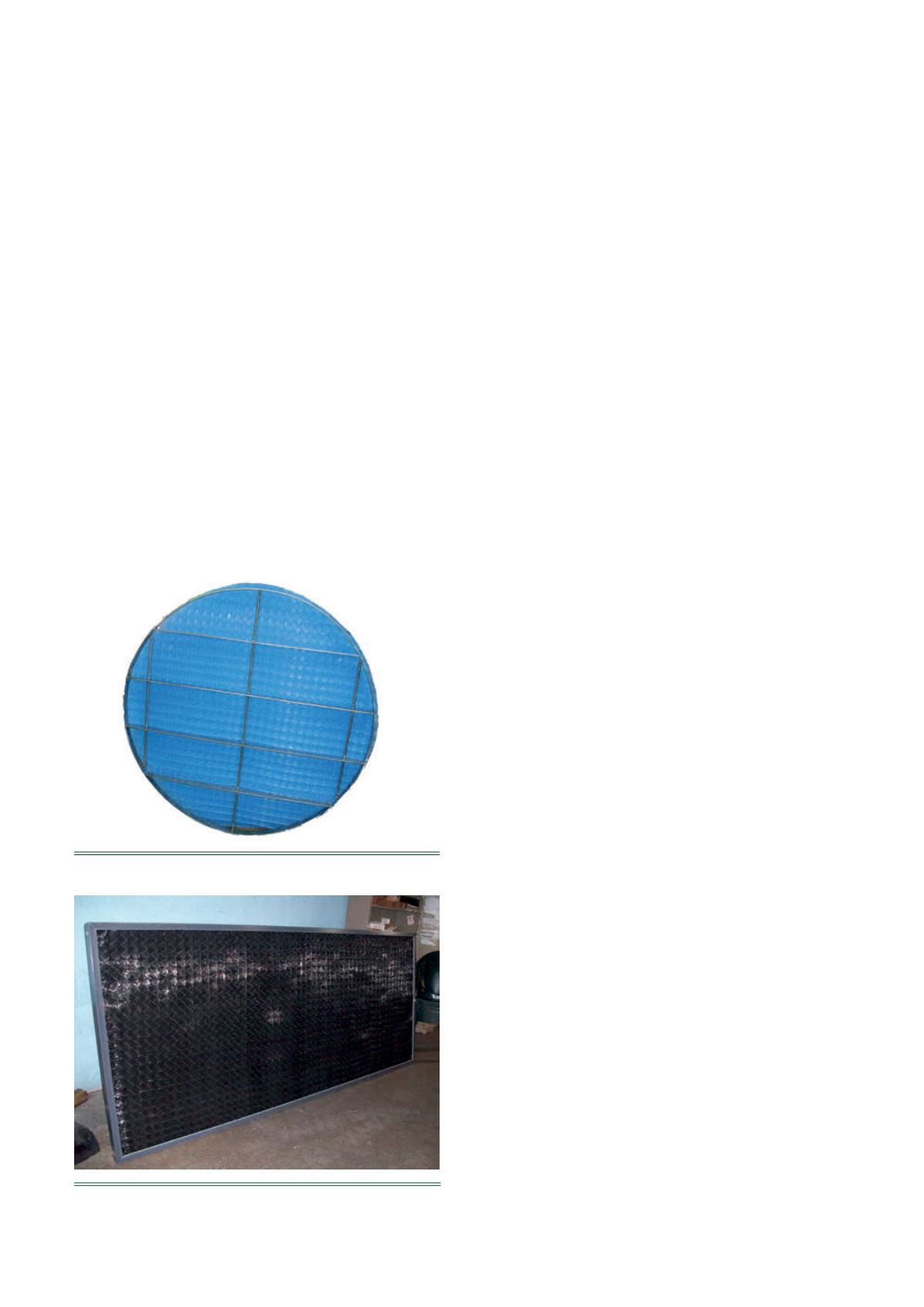
92
| WORLD FERTILIZER |
NOVEMBER 2016
followed by mass transfer of soluble component from
gaseous to liquid phase.
Cross/semi-cross flow scrubber
A cross or semi-cross flow (SXF) scrubber has been found
to have the most successful applications in phosphoric
acid, DAP, MAP, TSP, SSP and nitrogenous (urea, NPK, AN
and CAN) fertilizer processes. This type of wet scrubber
has been developed as a combined unit of spray and
structured packing sections housed horizontally in a box
with a mist eliminator inside for maximum separation of
soluble gases, particulate matter and mist particles below
2
µ
m size. They are classified under medium-energy
scrubbers having a pressure drop ( P) 6 – 9 in. water gauge,
unlike packed towers or venturi cyclonic/coaxial scrubbers
when used separately.
The design of cross or semi-cross flow (SXF™) scrubbers
includes the following:
n
Pre-cooling/wetting/pre-cleaning of particulate
matter and gaseous effluents.
n
Humidification/cooling/separation of medium to large
size particles of approximately 94 – 99% efficiency
between 5 – 50
µ
m size and soluble gases.
n
Stage-wise absorption of soluble gases and fine to
medium size (between 1 – 5
µ
m) particulate matter
using interlaced, ladder-like structured filament media,
for example KON-TANE.
n
Final separation of fine (<1
µ
m) size particles as mist and
‘aerosol’ particles using a B-GON® filament media of finer
styles, but one that is similarly structured to KON-TANE
in order to achieve 99.7 – 99.9% recovery.
The higher fluorine recovery or lowering of fluoride
pollution emission in the air at, or below, 0.013 lb/t P
2
O
5
input has been proven in the fertilizer industry. Dust
emissions from nitrogenous fertilizers have been reduced
to less than 10 mg/Nm
3
with Kimre advanced technology.
Mass transfer media
In gas cleaning, there is clearly a trade-off between
contaminant removal efficiency and energy consumption,
based on the pressure drop ( P) applied in the process.
However, the trade-offs between technologies are not
always clear if the benefits of efficient removal are not
fully recovered.
Kimre’s mass transfer media technology provides
particle elimination from the process at a low-pressure
drop within 6 – 7 in. water gauge. The interlacing media is
available in a variety of coarseness or styles. Different
styles can be combined in a single pad to provide the
optimum performance based on particulate separation
efficiency, pressure drop and cost.
The ladder-like structure of the monofilament media
creates sufficient flow turbulence in order to cause
intimate gas-liquid mixing over the maximum surface area,
allowing for mass transfer and particle separation by
inertial impaction, interception and Brownian diffusion.
Kimre KON-TANE contacting media uses the combined
effects of three mechanisms to maximise phase separation
and particle collection efficiency by providing sufficient
drainage of the liquid through a predetermined void space.
These pads can be configured according to different
functions, including the removal of heavy liquid load by
proper drainage, plugging resistance to avoid blinding,
coalescing or removal of small particles and of small
(0.8 – 3
µ
) to large (10 +
µ
) droplets. Additionally,
entrainment separation for the removal of large particles
using B-GON media can be considered during configuration.
The effectiveness of one layer of any type B-GON mist
eliminator can easily be calculated on a proprietary
software. The pads of different styles and combinations
are provided in rectangular or circular frames.
Multi-stage aerosol separation system
The SXF semi-cross flow scrubber body is easily adapted to
allow for addition of an AEROSEP® particle growth stage.
The principle of growing submicron sized particles to a 1
µ
m
or larger is that this is a size that can then be easily
collected and removed. A fine aerosol of ammonium
chloride (NH
4
Cl) provides a common example of a salt that
typically forms a very small aerosol size (0.1 – 0.4
µ
m). Small,
dry particles such as this will grow in size when presented
with a small amount of supersaturated water droplets. This
phenomenon is known as nucleated condensation. When
small, dry salt particles are presented with water droplets
that are substantially larger in size, a micro-condensation
Figure 3.
B-GON mist eliminator with stainless grids.
Figure 4.
Removable KON-TANE media cassette.


